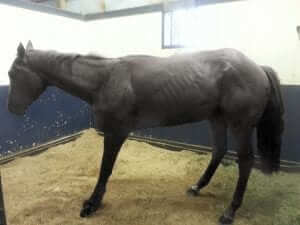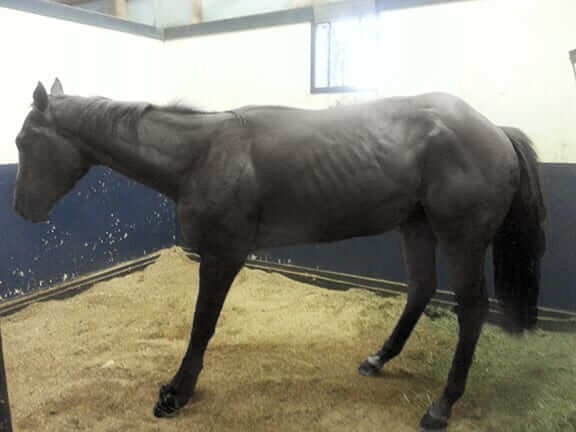Tying up, myositis, Monday Morning Disease, and azoturia all refer to which is more technically known as Equine Rhabdomyolysis Syndrome in horses. It can be a very common problem in some disciplines and breeds in the horse. The most common breeds impacted by the condition include the Quarter Horse, Thoroughbred, Arabian, and the draft horses. In various research papers, tying up has been noted in approximately 4% of Arabian Endurance horse and up to 10% of racing Thoroughbreds. Given the increase in the incidence and possible clinical repercussions of the condition on the performance of the horse, there has been much research trying to unravel the mystery as to what exactly causes the problem.
Clinical Signs of Tying Up and Rhabdomyolysis in the Horse

The clinical episodes of tying up are often seen as intermittent, meaning that it does not happen all of the time. The lag time between episodes in any one given horse can vary greatly. In most instances, the clinical event is usually connected with active exercise, but there have been reports of horses tying up with while grazing at pasture with no connection with hard or strenuous activity.
The clinical signs of a 'tying up' episode or rhabdomyolysis in the horse are usually increasing stiffness, which can progress to an animal that is unwilling to walk or move forward. In some instances, the condition can progress to where the horse is recumbent and unable to rise. Death can be a consequence in some cases due to renal failure or other metabolic pathways including shock. The muscles that appear to be most often affected are the larger muscle groups including the thigh, croup and loin region, but in actuality, any muscle group can be affected especially as the condition worsens. Usually the affected muscles appear tight, swollen, tender to the touch and warm to the touch. Another classic sign, which is not always present, is the gross discoloration of the urine to a dark red, which is termed myoglobinuria and a byproduct of kidney excretion of red blood cell byproducts and muscle damage. In most cases, the patients are actually anxious as they are in pain and cannot move without making the situation worse. Sometimes, they can actually be fractious.
One of the main points with a horse that is tying up is that clinically, it can resemble other conditions including colic, shear exhaustion, infection of the bladder (cystitis), laminitis and other neurological or musculoskeletal problems.
In the text, Equine Internal Medicine (Reed, 1998), they have divided the condition into three grades of severity. A mild form occurs shortly after exercise has been discontinued and the animal is cooled down or rested. An intermediate form occurs after 20-30 minutes of exercise and a more severe form in which the horse will demonstrate clinical signs within 10-20 minutes of exercise. There is another chart listed in this text which also grades the horses dependent on the severity of the stiffness and other clinical signs, but is not mentioned here due to space limitations.
Diagnosis of Tying Up and Rhabdomyolysis in the Horse
Most cases of rhabdomyolysis in the horse are diagnosed not only on presenting clinical signs such as stiffness, tight muscle groups, and discolored urine, but also through the use of blood work testing. On the typical serum chemistry panel, veterinarians usually note an increase in various enzymes including CK, LDH, AST, glucose, and even lactate. Often, we also have changes in kidney values including BUN and Creatinine, as well as changes in electrolytes and acid-base status. These enzymes are associated with muscle and kidney damage and their levels reflect the amount of damage that has occured. The higher the level, the worse the damage.
A urine evaluation is often done as well to rule out conditions such as urinary infections or other problems. In many cases, the urine often has a very dark red or coffee ground color dur to the presence of myoglobin, which is directly related to muscle damage. Kidney or renal damage is common in the more severe forms of rhabdomyolysis as it is common to have dehydration, shock in some instances and precipation of myoglobin within the tubules.
Causes of Tying Up and Rhabdomyolysis in the Horse
Research findings have indicated that there are potentially many factors involved in the development of rhabdomyolysis in horses with them all leading to the same end result or clinical signs. Some possible causes include: (Reed, 1998)
- Carbohydrate overload which leads to abnormal glucose utilization and glycogen storage, contributing to lactic acid accumulation
- Low oxygen levels within muscle tissues
- Thiamine deficiency
- Vitamin E and Selenium deficiency
- Metabolic Pathway abnormalities (genetic)
- Hormonal influences (estrus in mares)
- Low thyoid levels
- Electrolyte imbalances
- Infectious causes (viral and bacterial)
Each possible cause listed above has been noted in a varying degree of cases, but not all obviously. The majority of cases have been linked with accumulation of lactic acid within the muscle tissue, which can be associated with clinical signs. This accumulation can be a direct result of any of the above listed causes and varies often between one horse to another. There are also many other 'triggering factors' which include gender of the horse, temperament, environmental infuences, nutrition, weather, season and husbandry. So, as we can see, it can be very difficult to pinpoint exactly what causes a specific episode.
It has been suggested that rhabdomyolysis is a genetic condition, often linked with metabolic pathway abnormalities. In one study, it was noted that rhabdomyolysis was an autosomal dominant pattern of inheritance. (Dranchak, 2005) In many instances of such conditions, the various cell lines are not functioning properly or have defects in glucose metabolism.
Despite the cause, just as in other human and veterinary medical conditions, there is often an elevation in free radicals and evidence of oxidative stress, which is likely a result of the condition, but also a propellent in the course of progression and possible tissue damage. In one study, there was a noted decrease in serum Superoxide Dismutase, total antioxidant capacity and glutathione. (El Deeb, 2010). This helps to correlate with the concept of ongoing oxidative stress and excess free radical production, which may be depleting antioxidant reserves.
Treatment and Management of Tying Up and Rhabdomyolysis
The first step in managing or treating these cases is to make sure of what we are dealing with and that we aren't missing the boat in terms of actually having a colic or other situation. In some breeds, including the QH, conditions such as HYPP may actually mimick a case of tying up. Other injuries, including tendon injuries or muscle strains may also mimick the clinical signs. Forced walking is generally not recommended unless it is absolutely necessary as it can make the situation worse through progressive muscle damage.
A good clinical examination, including body temperature and assessment of hydration is paramount. In those cases that are clinically dehydrated and exhibiting signs of dark colored urine, it is essential to rehydrate them to preserve renal (kidney) function and help flush the body through to eliminate the myoglobin precipitates and other potential toxins that have build up. Rehydration is generally performed through intravenous fluids but if that is not an option, oral fluids through an NG tube may be utilized.
Other therapies that have been utilized include sodium bicarbonate in the IV fluids to help normalize the acid base status, vitamin E and selenium, DMSO and muscle relaxants including Methocarbamol and Dantrolene.
IV fluids are generally administered until the patient is fully rehydrated and the kidney bloodwork values have returned to normal. Muscle enzme elevations (CK, LDH, AST) may take time to come down, but they should be monitored and it is generally recommended not to return the patient to work until they have done so.
The diet during the recovery phase is more geared towards roughage in terms of hay with avoidance of cereal grains due to high carbohydrate levels.
The prognosis for full recovery is generally good in the mild cases, but can be more guarded in the more severe forms, especially if there is concurrent circulatory compromise and kidney damage.
Prevention and Thoughts for Additive Support
There are many thoughts on prevention, but it is really dependent on the underlying cause, which can be unique for each horse. Preventative measures that have been implemented in the past include the use of supplemental thyroid hormone, vitamin E and selenium, Dantrolene, and other miscellanous antioxidants and/or anti-inflammatories.
Diet is also a huge factor when it comes to managing the chronic or recurrent cases with a goal to balance the ration and reduce unnecessary carbohydrate or lower the NSC level. It is also important in the competition horse to make sure that they are readily hydrated and have electrolytes available, as both of these can contribute to the progression if in a state of deficiency.
I think that when it comes to these cases, it would be great to understand what exactly is happening with each of these animals, but that is not always possible, so we are left cleaning up the mess or damage created. If we can minimize this damage at a cellular level, then we could possibly slow the progression, decrease the severity and improve the recovery. Certain research articles have revealed that there is a depletion of antioxidant stores within the patients exhibiting rhabdomyolysis as well as increased level of various inflammatory cytokines or proteins. So, considering this, we have to ask the question is to whether or not there are options to intervene at this level? It may not prevent the condition in full, especially considering a genetic flaw, but there are possibilities that we could reduce frequency or severity of the bouts seen.
Antioxidant Support would potentially prove invaluble as a preventative measure. Vitamin E and Selenium are great starting points, but we need to keep in mind that antioxidants are quickly depleted and need 'recharging', thus they are best given in combination. The addition of other antioxidants including Vitamin C, CoEnzyme Q10 and even Alpha Lipoic Acid could prove beneficial. They are not only antioxidants themselves, but these in particular actually help to 'recharge' other antioxidants, helping to keep the body in balance.
Anti-inflammatories are potentially very beneficial as well as they can mitigate or impact the production of potentially damaging inflammatory cytokines. Given the current regulations in the competition arenas, most anti-inflammatories are banned and they can be dangerous in the dehydrated horse. Despite this, I feel that we can potentially do better and decrease the production of the cytokines in a more natural way. Certain herbs including Curcumin, Boswellia and even Ashwaghanda may prove of unique benefit to these horses as not only do these herbs posses the ability to modulate the inflammatory process, but they are also antioxidants, which helps to protect the cells against damage.
Other herbs that could prove beneficial include more 'nutritive' types with Spirulina as an example. Spirulina is full of beneficial protein, minerals and many vitamins, including B-vitamins that can be beneficial for cellular health, which includes the muscle tissue. Spirulina has also been shown to help detoxify the body and may help to combat acidic type of conditions including high lactate levels. It has also been shown to modulate the inflammatory process, so its use along with other herbs maybe very beneficial.
Amino acids including Glutamine, Arginine, Creatine and Carnitine also have potential value in management and prevention. These amino acids are vital to the body in regards to many cellular process and antioxidant support. They can be beneficial in terms of tissue repair, but could also be very important in terms of management and reduction of the severity of the condition.
I also think that it is important to determine whether or not hindgut health or lack of health plays a role in this condition. Many of the horses that I have treated that have tied up are heavier, stockier and likely prone to metabolic problems or deemed easy keepers. In our past research, we have demonstrated that many of these horses have variable levels of hindgut problems ranging from acidosis to bacterial population overgrowths to leaky gut syndrome. If this is present in the patient, then it has to be addressed as it is often a primary source of inflammatory problems.
In our patients, we have found great results when using our Cur-OST EQ Plus and EQ Immune formula, which helps to balance the inflammatory response, provide critical antioxidant support and also amino acids to help restore tissue function. In the easy keeper or metabolic patients, we will substitute the Cur-OST EQ Total Support for the EQ Plus formula. Experience tells me that through this regimen, the patients recover faster and more completely and future incidence of this condition is reduced and less severe in nature.
There is no cure for rhabdomyolysis in horse, but there are means of preventing or making the condition potentially more easy to manage. We cannot get around genetics, if that is the situation, but we can potentially reduce the impact or sequelae. The question ultimately comes as to how and which route is chosen?
For more information on PSSM in the horse, read this article.
I hope that this article helps to provide some answers.
Thank you,
Tom Schell, D.V.M.
Nouvelle Research, Inc.
tschelldvm@gmail.com



what would you suggest as correct or safe nsc of a feed fed to a pssm horse?